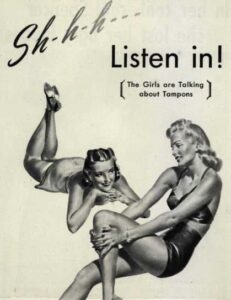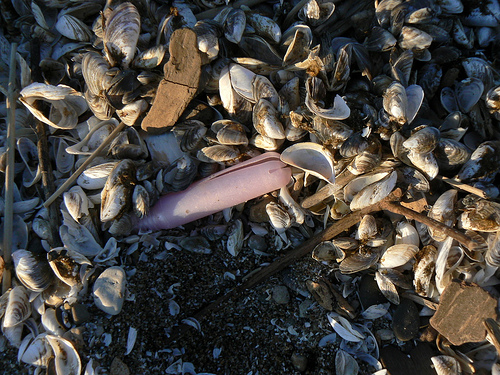Now before I get into this topic I want to address the readers who might be cringing here. While acknowledging that public discussion of menstruation is a bit on the taboo side socially, environmentally it does have an impact. As such it needs to be discussed openly. For something that happens to half of the human population, the whole process and associated products are treated with a bizarre amount of shame and secrecy. Fact is, it’s a big issue. It’s expensive economically, can have serious health effects and produces a lot of waste. When it comes to environmental issues, pretending like it doesn’t happen or doesn’t have an environmental effect is a problem in and of itself.
So girls, and guys who know girls, this is important. No snickering. Pay attention. Thank you.
Commercial tampons were introduced to the public in the US around the 1930’s. Tampax was the first brand to be sold with an applicator in 1936. The basic design and concept has more or less stayed the same ever since. The main selling points of the products revolved mainly around comfort, ease of movement and athleticism, discretion, coverage and absorbency. For a brief period in the early nineties, the brand Tampax advertised their product as “environmentally friendly” urging women to “think green” by buying the brand with a biodegradable applicator.
But how “green” are these products, really?
Environmentally, there are two main issues at stake: the impact of production, and the impact disposal. A typical woman can use anywhere between 8,000 to 17,000 tampons in her lifetime. This depends on individual usage of course. I hate to sound cliche here, but every woman is different, and the numbers available are all over the map. Think about it though, a handful of products a month, 12 months a year, for 30 to 40 years, multiplied by the female half of the population… It really does add up. According to the book Flow: The Cultural History of Menstruation, the average woman throws away up to 300 pounds of feminine hygiene related products in a lifetime. In the grand scheme of things this makes up only about 0.5 percent of personal landfill waste. But even so, when you see that there are alternative options available, it becomes difficult to rationalize. In the United States alone, an estimated 12 billion pads and 7 billion tampons are disposed of annually. Each of those tampons and pads has an environmental impact of the waste of not only the product itself, but the packaging, plastic or cardboard applicators, as well as the less visible costs of transportation and production.
The Royal Institute of Technology in Stockholm carried out a life cycle assessment (LCA) comparison of the environmental impact of tampons and sanitary pads. Their “cradle to grave” assessment of the raw material extraction, transportation, production, use and waste management stages took three main impact categories into consideration: human health, ecosystem quality and resource use.
They found that the main environmental impact of the products was in fact caused by the processing of raw materials, particularly LDPE (low density polyethelene) – or the plastics used in the backing of pads and tampon applicators, and cellulose production. As production of these plastics requires a lot of energy and creates long lasting waste, the main impact from the life cycle of these products is fossil fuel use, though the waste produced is significant in its own right. In a choice between pads and tampons, pads have more of an environmental impact due to their plastic components. It’s essentially the feminine hygiene version of “paper or plastic?”That isn’t to say that tampons don’t also have a significant environmental impact. The cotton fiber used in the production of tampons contributes 80% of their total impact. The processing is resource intensive as the farming of cotton requires large amounts of water, pesticides and fertilizer. And while they do not last indefinitely, like the plastic liners used in pads, tampons still take about six months to biodegrade according to Liz Sutton of the Women’s Environmental Network. Really, it’s the plastic applicators that are a problem. In 2009, The Ocean Conservancy’s International Coastal Cleanup project collected 20,000 tampon applicators out of 4 million total pieces of reclaimed plastic waste. It can take applicators 25 years to break down in the ocean. Once they are broken down, they are often ingested by marine life causing digestion blockage and death. I’m going to say this once: don’t flush the plastic applicators. It even says right there in the directions not to flush the plastic applicators. In fact, if it’s an option – go ahead and throw the whole thing away rather than flushing. The cotton is often the cause of plumbing problems at home (around 70%) and at the treatment plant where they are removed as solid waste and sent to landfills anyway.
Some women are wary of tampons in general as all brands come tagged with warnings about TSS, or toxic shock syndrome, a rare but serious health condition which can occur in women who use super-absorbent or synthetic tampons. There are other health precautions as well. As I discussed in the food as an environmental issue post, health is an environmental issue, so these issues shouldn’t be overlooked. The chlorine bleaching process that is used to make these products look “cleaner” or more sanitary produces dioxin, the toxin of Agent Orange and Love Canal fame, which builds up in the fat cells of our bodies over time. Products that contain rayon also carry trace amounts of dioxin. While the FDA and Health Canada both state that the health risk is negligible, Dr. Philip Tierno of New York University Medical Center says that while trace quantities of dioxin found in tampons aren’t in and of themselves the issue, it’s the overall exposure and build up that the use of chlorine-bleached and rayon based tampons adds to that’s the problem. To avoid dioxin related health risks associated with tampons, switch to a brand that is non chlorine-bleached, rayon-free, and 100% organic cotton, thus avoiding the insecticides, pesticides and herbicides that are used in the growing of non-organic cotton crops.While organic cotton tampons may solve the issue of pesticides and bleach, they still inevitably cause waste.
Alternative Options
If you’re really that convinced that you can’t go through life without tampons but still want to green your routine, cut back on a significant amount of trash by not using plastic applicators. For that matter, why not skip applicators all together? You can also go organic as there are a number of options available to you. In particular, check out 7th Generation, and Natracare.While it is true that tampons have less of an environmental impact than pads, there are other options. The green favorite being, of course, the menstrual cup. They provide the convenience of tampons without the waste, and a lot of women think they’re pretty much the best option available today. You insert them like a tampon, empty out as needed, and clean with soapy water. They are reusable, contain no dioxin, no rayon, and are easy to maintain. You can buy versions made out of natural latex or silicone. They are not only the most eco-friendly but also the most affordable of all options on the market. Check out the Keeper, the Moon Cup, or the Diva Cup.
For those who prefer external-use products, there are greener options for you too. Reusable cloth pads, such as Luna Pads, and Glad Rags, are machine-washable fabric maxi pads. They require some energy and water to clean, obviously, but they do save on overall resource use, avoid plastic production, and create minimal waste.
I know that changing habits like these is particularly difficult. Marketing studies show that often women will buy the brand of tampons or pads their mothers used and rarely diversify. But to those of us who know that there are more important elements to our consumer choices than brand loyalty, it’s worth it to give the alternatives a try.
Vintage ads from Duke University Library Ad Access.




Comments 25
What a wonderful article. I especially appreciate all the research that went into writing it. And the facts speak for themselves: Disposable menstrual products are, indeed, a scourge upon our environment!
For a pictorial representation of the amount of actual waste caused by using (and then tossing) disposable menstrual products, please take a look at these comparison photos on keeper.com, The Keeper, Inc.’s official website. These photos show the amount of waste that is caused by one woman’s use of tampons in (a) one month, (b) 1 year, (c) 10 years, and (d) a lifetime.
(HINT: we needed a DUMP TRUCK to show one woman’s lifetime use!!)
To view the photo, please go to Keeper.com, and click on “New: Photos” in red on the left.
Again, thanks so much for writing about this very important topic. People have been “in the closet” about it far too long.
By the way, I interviewed Elissa Stein, co-author of FLOW, for Keeper.com. It’s a wonderful interview. To listen to it, go to our website. On the left, click on “New: Audio Interviews.” Elissa’s is the first interview listed.
Again, thanks for addressing this very important topic. A great job!!
Julia Schopick
Keeper.com
Pingback: Quick Green Reads For The Weekend Volume 161. | The Good Human
Pingback: Friday Green Links – 4/23 « Pragmatic Environmentalism
Pingback: Softcup: Green and Reusable | Groovy Green Livin
Pingback: You Put What? Where? | Samvid Beauty
Pingback: Use your finger! « The skinny and the fat
Pingback: Groen & Ongesteld: de Menstruatiecup « Vieze Hippie
Pingback: 9 Ways to Waste Less, and Save More - A Proverbs 31 Wife
Pingback: Menstrual Cups: The Future of Periods - Wondergressive
Pingback: Menstrual Cups: The Sustainable Period - Wondergressive
Pingback: 5 Reason Why I Love My Diva Cup! - Modern Hippie Housewife
Pingback: Me and My Menstrual Cup: A Love Story - The Radical Notion
Pingback: Let’s Be Blunt: Tampons, Pads, and Menstrual Cups – Redhead Tree Hugger
Pingback: Me and My Menstrual Cup: A Love Story | quiotgrrrl
Pingback: Reasons to Try a Menstural Cup
Pingback: Why I Switched to a Menstrual Cup - Family Sprouts
Pingback: The cup that can save women thousands of dollars — oh, and the Earth, too | Mothership.SG
Pingback: Encouraging Empathy: The Menstrual Misery Simulator |
Pingback: Tampon Taboo and Flushing – Washed up
Pingback: OI – The Organic Initiative | NZ Startup of the Week
As a woman who grows most her own food, meat included, as well as has her family’s very own water supply, I probably know a bit more about going green then most, if not all here. In today’s society, going all green is very difficult, and most when they realize how much real work is involved, (think farmers) decide they don’t really want to do it. But we should do the best we can. Baby steps one choice at a time. It took years of baby steps for me to get to this point, and I only recently learned of menstrual cups. So this is my next baby step. After much thinking and research I’ve concluded: One thing is to avoid made in China products. Even cups. Not meaning to pick on one group, but it is counter productive to do business with a country who’s track record for being “clean” is so horrendous. The U.S isn’t as great as other nations, but d@mn, we’re better then THAT. Also buy local. This will reduce the amount of energy and fuel it takes to get products to your door.
Pingback: Tampons are so 1997! Time for zero-waste feminine hygiene – Millennial Mutt
Pingback: Powerful Environmental Reasons To Switch To A Menstrual Cup
Pingback: The Perils of Plastic Applicator Tampons - Our Blog
Pingback: The Amazingness that is the Menstrual Cup - Ode to a Feminist Product - Katie Scarlett Needs Money